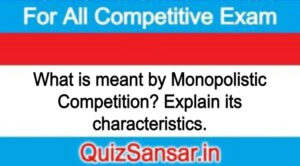
What is meant by Monopolistic Competition? Explain its characteristics.
What is meant by Monopolistic Competition? Explain its characteristics.
Ans.
Monopolistic competition refers to a market situation where there are many firms selling a differentiated product. “There is competition which is keen, though not perfect, among many firms making very similar products.” No firm can have any perceptible influence on the price-output policies of the other sellers nor can it be influenced much by their actions. Thus monopolistic competition refers to competition among a large number of sellers producing close but not perfect substitutes for each other.
It’s Features
The following are the main features of monopolistic competition:
(1) Large Number of Sellers: In monopolistic competition the number of sellers is large. They are “many and small enough” but none controls a major portion of the total output. No seller by changing its price-output policy can have any perceptible effect on the sales of others and in turn be influenced by them. Thus there is no recognised interdependence of the price-output policies of the sellers and each seller pursues an independent course of action.
(2) Product Differentiation: One of the most important features of the monopolistic competition is differentiation. Product differentiation implies that products are different in some ways from each other. They are heterogeneous rather than homogeneous so that each firm has an absolute in the production and sale of a differentiated product. There is, however, slight difference between one product and other in the same category.
Products are close substitutes with a high cross-elasticity and not perfect substitutes. Product “differentiation may be based upon certain characteristics of the products itself, such as exclusive patented features; trade-marks; trade names; peculiarities of package or container, if any; or singularity in quality, design, colour, or style. It may also exist with respect to the conditions surrounding its sales.”
(3) Freedom of Entry and Exit of Firms: Another feature of monopolistic competition is the freedom of entry and exit of firms. As firms are of small size and are capable of producing close substitutes, they can leave or enter the industry or group in the long run.
(4) Nature of Demand Curve: Under monopolistic competition no single firm controls more than a small portion of the total output of a product. No doubt there is an element of differentiation nevertheless the products are close substitutes. As a result, a reduction in its price will increase the sales of the firm but it will have little effect on the price-output conditions of other firms, each will lose only a few of its customers.
Likewise, an increase in its price will reduce its demand substantially but each of its rivals will attract only a few of its customers. Therefore, the demand curve (average revenue curve) of a firm under monopolistic competition slopes downward to the right. It is elastic but not perfectly elastic within a relevant range of prices of which he can sell any amount.
(5) Independent Behaviour: In monopolistic competition, every firm has independent policy. Since the number of sellers is large, none controls a major portion of the total output. No seller by changing its price-output policy can have any perceptible effect on the sales of others and in turn be influenced by them.
(6) Product Groups: There is no any ‘industry’ under monopolistic competition but a ‘group’ of firms producing similar products. Each firm produces a distinct product and is itself an industry. Chamberlin lumps together firms producing very closely related products and calls them product groups, such as cars, cigarettes, etc.
(7) Selling Costs: Under monopolistic competition where the product is differentiated, selling costs are essential to push up the sales. Besides, advertisement, it includes expenses on salesman, allowances to sellers for window displays, free service, free sampling, premium coupons and gifts, etc.
(8) Non-price Competition: Under monopolistic competition, a firm increases sales and profits of his product without a cut in the price. The monopolistic competitor can change his product either by varying its quality, packing, etc. or by changing promotional programmes.






